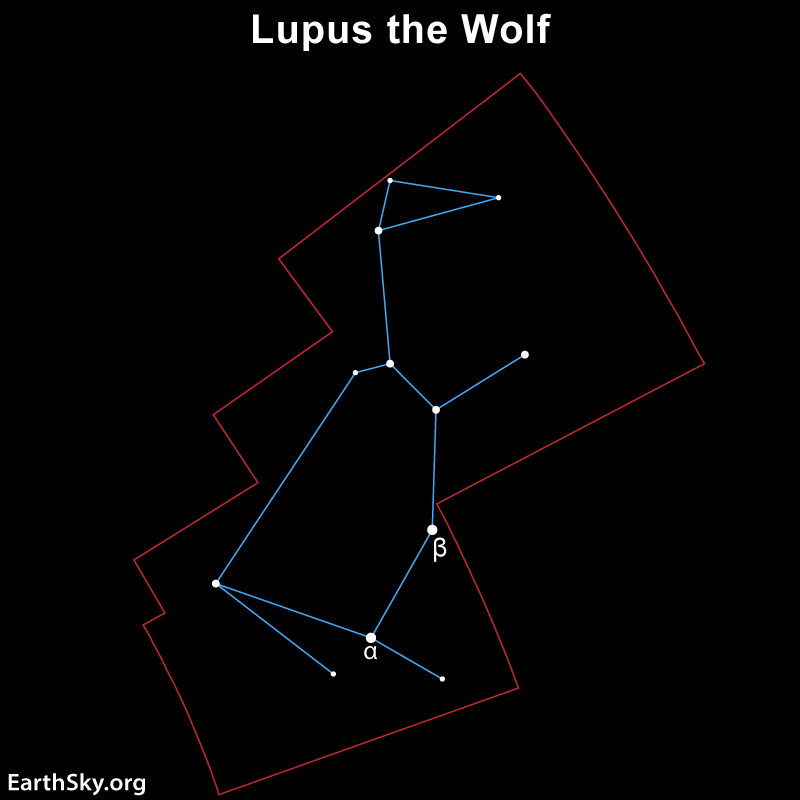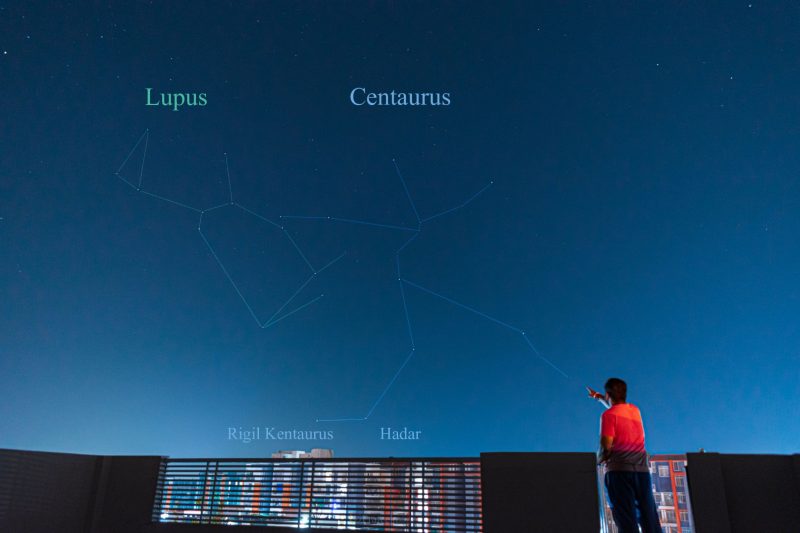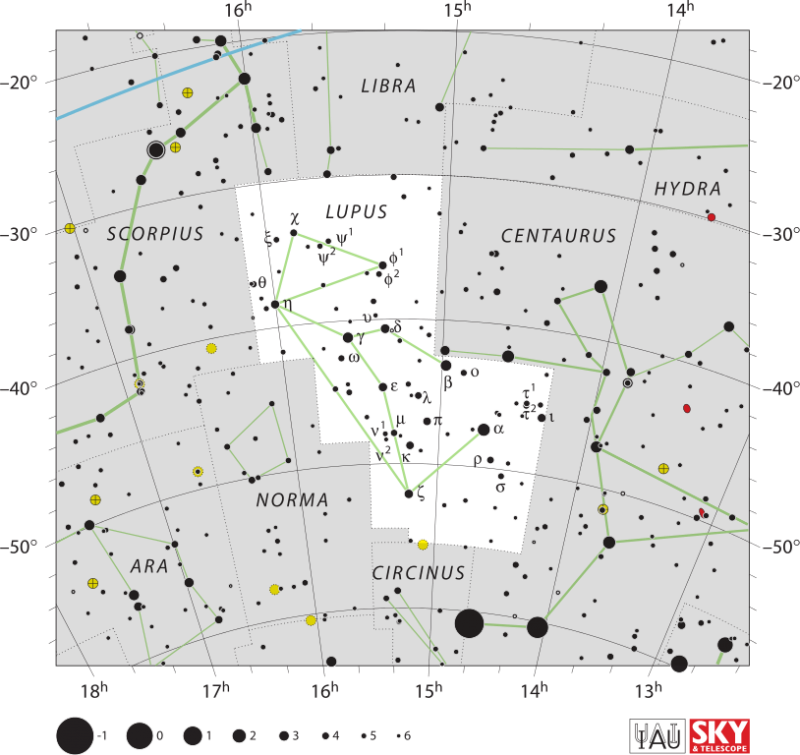
Lupus is an unassuming constellation whose name means wolf in Latin. The astronomer Ptolemy named Lupus and 47 other constellations in the 2nd century CE. Lupus is boxed in by two larger, brighter and better known constellations: Scorpius and Centaurus.
How to find Lupus the Wolf
Lupus is located south of the ecliptic. If you want to see it, you’ll need to be in the Southern Hemisphere or southward of Florida in the Northern Hemisphere. April through September are the best months to spot Lupus. The Wolf sits beside the constellation Norma the Carpenter’s Square. Scorpius the Scorpion is one of the noticeable constellations that border Lupus, and Centaurus lies on the opposite side.
The stars in Lupus are dim; therefore, you may want to trace out the forms of the Scorpion and Centaur first. Then look toward the dark patch of sky between them. Lupus and Norma both reside here: Lupus has brighter stars and sits farther north than Norma.
Lupus looks vaguely like the wolf it represents. Plus. from the Northern Hemisphere, you may only see the head of the Wolf near Scorpius. From the south, Lupus will be close to overhead on June evenings.

Stars of the Wolf
The main stars in Lupus are mostly 2nd and 3rd magnitude. The stars near the pincers of Scorpius form a triangle that marks the head of Lupus the Wolf. These stars are Eta Lupi, 440 light-years away, Theta Lupi at a distance of 410 light-years, and Chi Lupi, 470 light-years.
Four stars mark the curve of the Wolf’s body: Gamma Lupi at a distance of 420 light-years, Delta Lupi at 880 light-years and Beta Lupi at 383 light-years. Last is the brightest star in Lupus, magnitude 2.29 Alpha Lupi at a distance of 460 light-years.
Two brighter stars seem to hang down from Beta Lupi and mark the front leg of the wolf. However, these stars are classified as part of Centaurus the Centaur.
If you scan the boundaries of the constellation Lupus with a telescope, you’ll find many double stars and star clusters. Although Lupus is juxtaposed on the Milky Way, it does not have many bright deep-sky observing targets for binocular users.

Bottom line: Lupus the Wolf is a constellation that lies between Scorpius and Centaurus. You have to be farther south on the globe to see the Wolf.
The post Lupus the Wolf, a constellation in southern skies first appeared on EarthSky.
from EarthSky https://ift.tt/cCsfK1b

Lupus is an unassuming constellation whose name means wolf in Latin. The astronomer Ptolemy named Lupus and 47 other constellations in the 2nd century CE. Lupus is boxed in by two larger, brighter and better known constellations: Scorpius and Centaurus.
How to find Lupus the Wolf
Lupus is located south of the ecliptic. If you want to see it, you’ll need to be in the Southern Hemisphere or southward of Florida in the Northern Hemisphere. April through September are the best months to spot Lupus. The Wolf sits beside the constellation Norma the Carpenter’s Square. Scorpius the Scorpion is one of the noticeable constellations that border Lupus, and Centaurus lies on the opposite side.
The stars in Lupus are dim; therefore, you may want to trace out the forms of the Scorpion and Centaur first. Then look toward the dark patch of sky between them. Lupus and Norma both reside here: Lupus has brighter stars and sits farther north than Norma.
Lupus looks vaguely like the wolf it represents. Plus. from the Northern Hemisphere, you may only see the head of the Wolf near Scorpius. From the south, Lupus will be close to overhead on June evenings.

Stars of the Wolf
The main stars in Lupus are mostly 2nd and 3rd magnitude. The stars near the pincers of Scorpius form a triangle that marks the head of Lupus the Wolf. These stars are Eta Lupi, 440 light-years away, Theta Lupi at a distance of 410 light-years, and Chi Lupi, 470 light-years.
Four stars mark the curve of the Wolf’s body: Gamma Lupi at a distance of 420 light-years, Delta Lupi at 880 light-years and Beta Lupi at 383 light-years. Last is the brightest star in Lupus, magnitude 2.29 Alpha Lupi at a distance of 460 light-years.
Two brighter stars seem to hang down from Beta Lupi and mark the front leg of the wolf. However, these stars are classified as part of Centaurus the Centaur.
If you scan the boundaries of the constellation Lupus with a telescope, you’ll find many double stars and star clusters. Although Lupus is juxtaposed on the Milky Way, it does not have many bright deep-sky observing targets for binocular users.

Bottom line: Lupus the Wolf is a constellation that lies between Scorpius and Centaurus. You have to be farther south on the globe to see the Wolf.
The post Lupus the Wolf, a constellation in southern skies first appeared on EarthSky.
from EarthSky https://ift.tt/cCsfK1b

Aucun commentaire:
Enregistrer un commentaire